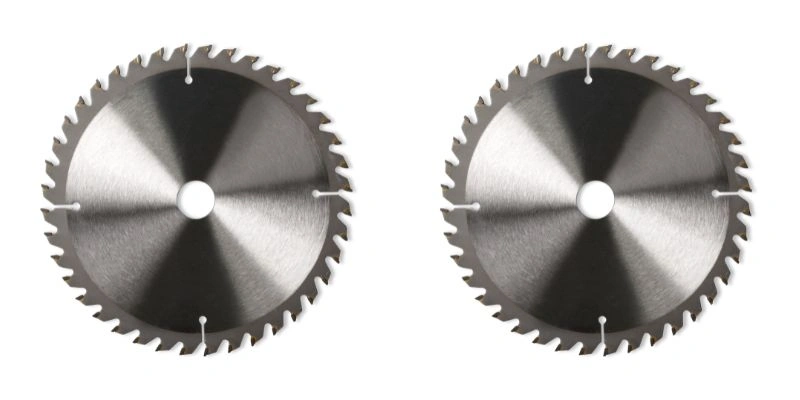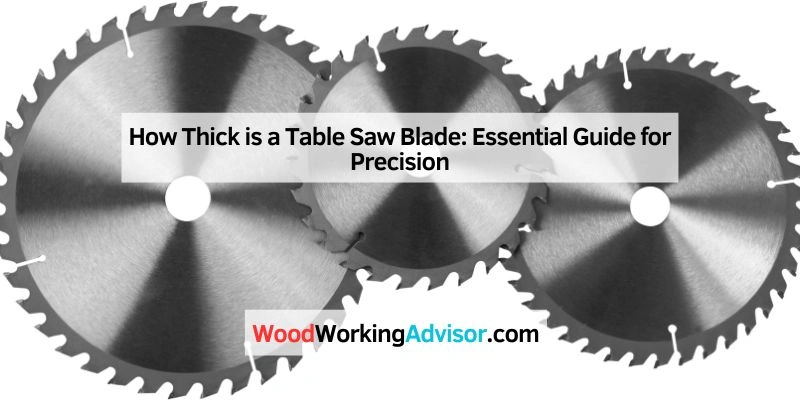A standard table saw blade thickness typically ranges from 0.094 to 0.125 inches. Specialty blades may vary slightly in thickness.
Understanding table saw blade thickness is crucial for achieving precise cuts in woodworking projects. The thickness affects the kerf, or the material removed during cutting. This detail influences the fit of joints and overall project accuracy. Different materials and blade types require specific thicknesses to perform optimally.
For instance, a thinner blade generates less waste but may lack stability. In contrast, thicker blades offer durability but may create wider cuts. Selecting the right thickness ensures efficient cutting and enhances the quality of your work. Knowing these details can elevate your woodworking skills and project outcomes significantly.
Introduction To Table Saw Blade Thickness
Table saw blade thickness is very important for woodworking. It affects the cut quality and speed of your projects. Thicker blades can handle harder materials. They create cleaner cuts and less tear-out.
Thin blades are lighter and cut faster. They are great for detailed work. Choosing the right thickness helps in achieving desired results. It also impacts the safety of the saw. Always consider the type of wood you will cut.
A good blade thickness improves the life of your saw and blade. It reduces vibration and increases accuracy. Understanding these factors can make your woodworking more enjoyable.

Types Of Table Saw Blades
Table saw blades come in various types to suit different tasks. Standard blades have a thickness of about 1/8 inch. They are versatile and great for general cuts.
Thin-kerf blades are thinner, typically around 3/32 inch. This design reduces waste and allows for faster cuts. They work well for softwoods and plywood.
Specialty blades serve specific purposes. Examples include rip blades and crosscut blades. These have unique teeth designs for efficiency in cutting.
Measuring Blade Thickness
Measuring the thickness of a table saw blade is simple. First, gather the tools required for this task.
Here is a list of necessary tools:
| Tool | Purpose |
|---|---|
| Caliper | To measure the blade thickness accurately. |
| Ruler | To check the overall size of the blade. |
| Safety Goggles | To protect your eyes during measurement. |
| Gloves | To ensure safe handling of the blade. |
Follow these steps to measure the blade thickness:
- Turn off the saw and unplug it.
- Remove the blade from the saw carefully.
- Use a caliper to measure the thickness.
- Record the measurement for future reference.
Factors Influencing Blade Thickness
The material of the blade affects its thickness. Common materials include high-speed steel and carbide. Carbide blades are often thicker for durability.
The type of cut desired also influences blade thickness. Thicker blades create smoother cuts. Thinner blades are better for intricate designs.
Saw motor power plays a role in blade thickness. Higher power allows for thicker blades. Thinner blades may struggle with tougher materials.
Thin-kerf Blades Vs. Full-kerf Blades
Thin-kerf blades are usually about 1/16 inch thick. They create less waste. This makes them great for small projects. They require less power from the saw.
Full-kerf blades are thicker, around 1/8 inch. They provide a more stable cut. This is helpful for larger projects. However, they create more waste.
| Type of Blade | Advantages | Disadvantages |
|---|---|---|
| Thin-Kerf | Less waste, requires less power | Less stability, may not last as long |
| Full-Kerf | Stable cuts, better for larger projects | More waste, requires more power |
Choosing the right blade is essential. Consider your project size. Think about the materials you will use. The right blade makes cutting easier and safer.
Tips For Maintaining Optimal Blade Thickness
Regular cleaning keeps your table saw blade in great shape. Remove dust and resin after each use. Use a soft brush or cloth for best results. Avoid using harsh chemicals that can damage the blade.
Proper storage helps maintain blade thickness. Store blades in a protective case or rack. Keep them away from moisture and extreme temperatures. This prevents rust and warping.
Sharpening techniques are vital for a sharp blade. Use a sharpening stone or file. Follow the manufacturer’s guidelines for angle and pressure. Regular sharpening improves cutting performance and extends blade life.
Safety Considerations
Safety is very important when using table saws. Always wear protective gear like goggles and gloves. Keep your hands away from the blade. Use a push stick to guide the wood safely.
Handling blades needs special care. Check for dullness or damage before each use. A sharp blade cuts better and is safer. Store blades in a safe place to avoid accidents.
Adjusting saw settings correctly is crucial. Make sure the blade is aligned properly. Use a ruler to measure the blade height. Test the saw with scrap wood before cutting your project.
Advanced Topics In Blade Thickness
The thickness of a table saw blade affects its performance. Thicker blades can handle more pressure. They stay stable during cuts, leading to cleaner edges. Thin blades may bend, causing rough cuts.
Material also plays a role. High-quality steel blades resist burning. Carbide-tipped blades last longer and cut better. Proper blade thickness helps prevent material burn during use.
| Blade Thickness | Impact |
|---|---|
| Thin Blades | More flex, rough cuts |
| Thick Blades | Stable, clean cuts |
| High-Quality Material | Less burn, longer life |

Frequently Asked Questions
How Thick Are Table Saw Blades?
Table saw blades typically range from 0. 094 inches (2. 4 mm) to 0. 125 inches (3. 2 mm) in thickness. The exact thickness depends on the type of blade and its intended use. Thicker blades are more robust but may produce wider kerfs.
Choose the right thickness based on your cutting needs.
What Are The Different Types Of Table Saw Blades?
Common types of table saw blades include rip blades, crosscut blades, and combination blades. Rip blades have fewer teeth for faster cuts along the grain. Crosscut blades feature more teeth for cleaner cuts across the grain. Combination blades offer versatility for both cutting styles.
Does Blade Thickness Affect Cutting Performance?
Yes, blade thickness can significantly impact cutting performance. Thicker blades produce wider cuts, which may result in more material removal. However, thinner blades can provide finer cuts with less drag. The choice of thickness should align with your specific project requirements for optimal results.
What Thickness Is Best For Hardwood Cutting?
For hardwood cutting, a blade thickness of around 0. 125 inches (3. 2 mm) is recommended. This thickness ensures stability and durability while cutting dense materials. It minimizes blade flex, allowing for cleaner, more accurate cuts. Always match the blade type to your specific hardwood species for best outcomes.
Conclusion
Choosing the right table saw blade thickness is crucial for your woodworking projects. Thicker blades offer durability, while thinner blades provide cleaner cuts. Understanding these differences helps you make informed decisions. Always consider your material and desired finish. With the right blade, your cuts will be precise and efficient.

